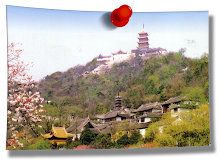

Today a historical monument, Peleş Castle is a Neo-Renaissance castle placed in an idyllic setting in the Carpathian Mountains, near Sinaia, in Prahova County, Romania, on an existing medieval route linking Transylvania and Wallachia, built between 1873 and 1883. The first architect was the Viennese Wilhelm von Doderer (1825-1900) and then German Johannes Schultz (1876-1883). Later additions were made between 1893 and 1914 by the Czech architect Karel Liman, who added designed the towers, including the main central tower, 66 m in height.
By form and function, Peleş, is truly a palace but affectionately and consistently called a castle instead, by all. Its architectural style is a Neo-Renaissance of romantic inspiration that can find a corespondent in 19th century ideals with the monumental Gothic Revival of Schloss Neuschwanstein in Bavaria, ironically called a castle as well. A Saxon influence can be observed in the interior courtyard facades that have rich and ornated fachwerk similar to northern Europe alpine architecture and allegorical hand painted murals. Interior decoration is mostly a Baroque influence with heavy carved woods and exquisite fabrics.
Peleş Castle has 3.200 sq. meters of floor plan, over 170 rooms, 30 bathrooms, many with dedicated themes from world cultures (in similar fashion with other Romanian palaces, like Cotroceni Palace for example), themes that can vary by function (offices, libraries, armouries, art galleries) or by style (Florentine, Turkish, Moorish, French, Imperial) all extremely lavishly furnished and decorated to the slightest detail. The establishment hosts one of the finest collections of art in East and Central Europe, consisting of statues, paintings, furniture, arms and armour, gold, silver, stained glass, ivory, fine china, tapestries and rugs; the collection of arms and armour has over 4.000 pieces, divided between Eastern and Western war, ceremonial or hunting spreading over four centuries in history. Oriental rugs come from the finest sources: Bukhara, Mosul, Isparta, Saruk and Smirna, porcelain from Sevres and Meissen, leather from Córdoba but perhaps the most acclaimed are the hand painted stained glass vitralios, mostly Swiss. A towering statue of King Carol I by Raffaello Romanelli overlooks the main entrance but many other statues are present on the seven Italian neo-Renaissance terrace gardens, mostly of Carrara marble executed by the Italian sculptor Romanelli. The gardens also host fountains, urns, stairways, guarding lions, marble paths and other decorative pieces.
By form and function, Peleş, is truly a palace but affectionately and consistently called a castle instead, by all. Its architectural style is a Neo-Renaissance of romantic inspiration that can find a corespondent in 19th century ideals with the monumental Gothic Revival of Schloss Neuschwanstein in Bavaria, ironically called a castle as well. A Saxon influence can be observed in the interior courtyard facades that have rich and ornated fachwerk similar to northern Europe alpine architecture and allegorical hand painted murals. Interior decoration is mostly a Baroque influence with heavy carved woods and exquisite fabrics.
Peleş Castle has 3.200 sq. meters of floor plan, over 170 rooms, 30 bathrooms, many with dedicated themes from world cultures (in similar fashion with other Romanian palaces, like Cotroceni Palace for example), themes that can vary by function (offices, libraries, armouries, art galleries) or by style (Florentine, Turkish, Moorish, French, Imperial) all extremely lavishly furnished and decorated to the slightest detail. The establishment hosts one of the finest collections of art in East and Central Europe, consisting of statues, paintings, furniture, arms and armour, gold, silver, stained glass, ivory, fine china, tapestries and rugs; the collection of arms and armour has over 4.000 pieces, divided between Eastern and Western war, ceremonial or hunting spreading over four centuries in history. Oriental rugs come from the finest sources: Bukhara, Mosul, Isparta, Saruk and Smirna, porcelain from Sevres and Meissen, leather from Córdoba but perhaps the most acclaimed are the hand painted stained glass vitralios, mostly Swiss. A towering statue of King Carol I by Raffaello Romanelli overlooks the main entrance but many other statues are present on the seven Italian neo-Renaissance terrace gardens, mostly of Carrara marble executed by the Italian sculptor Romanelli. The gardens also host fountains, urns, stairways, guarding lions, marble paths and other decorative pieces.































No comments:
Post a Comment